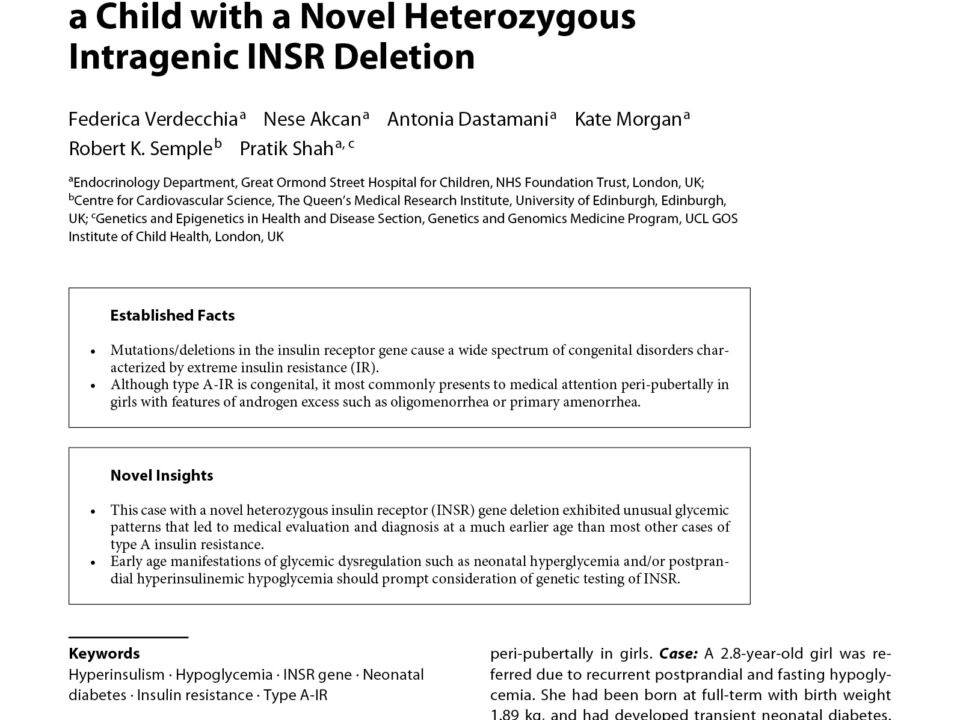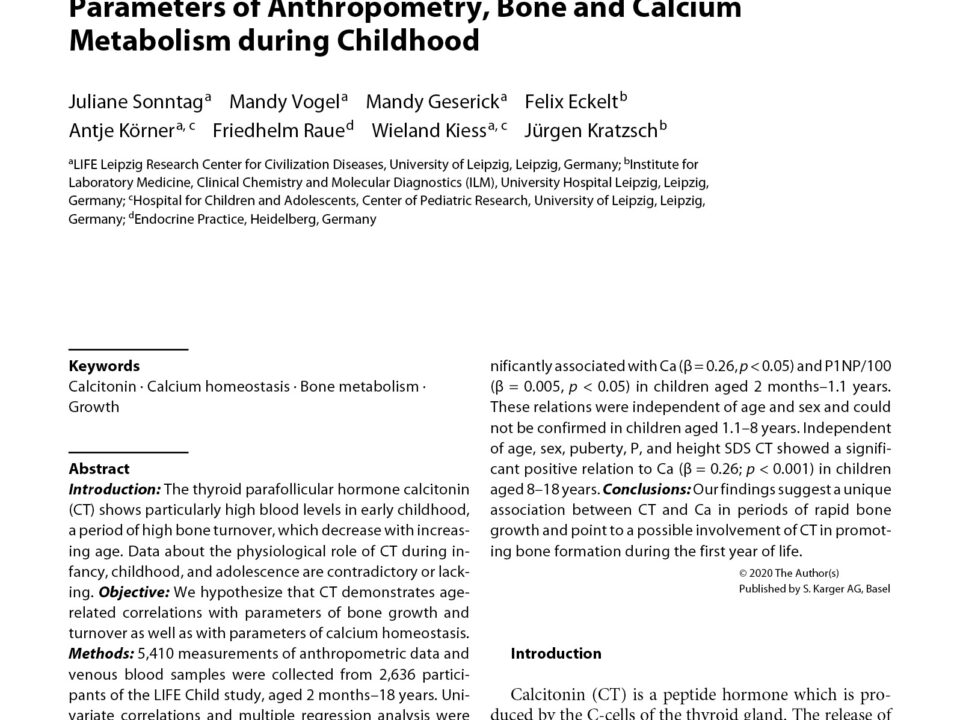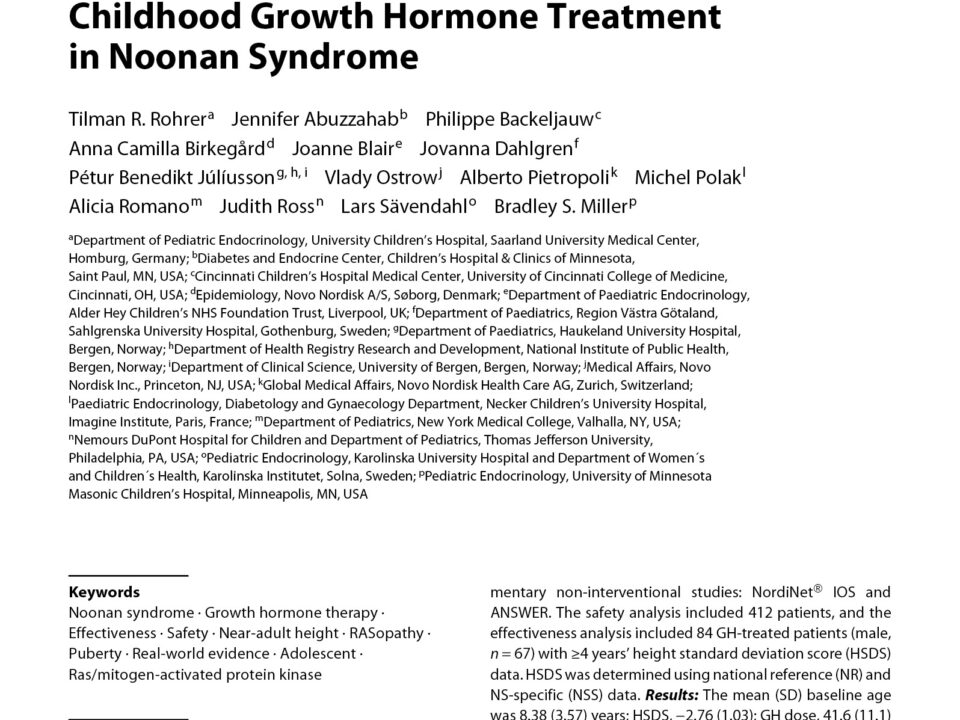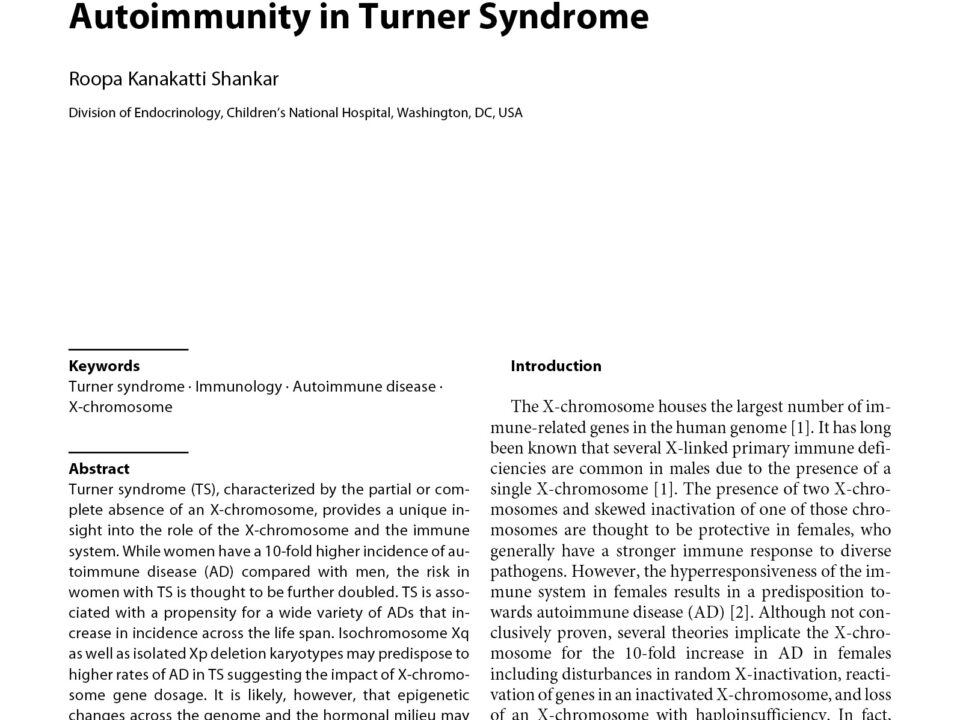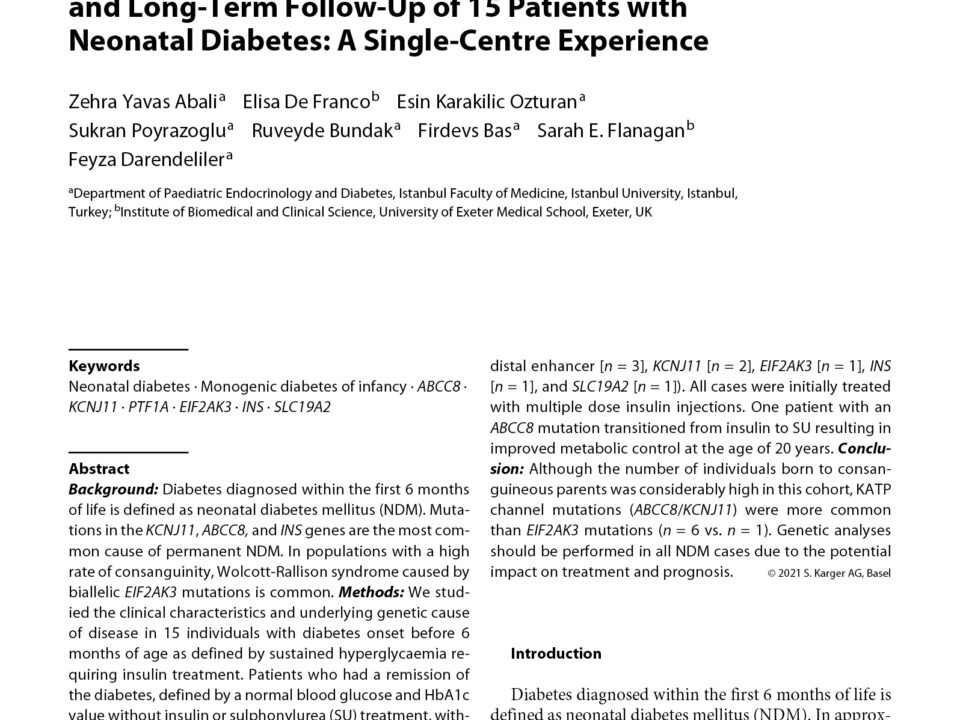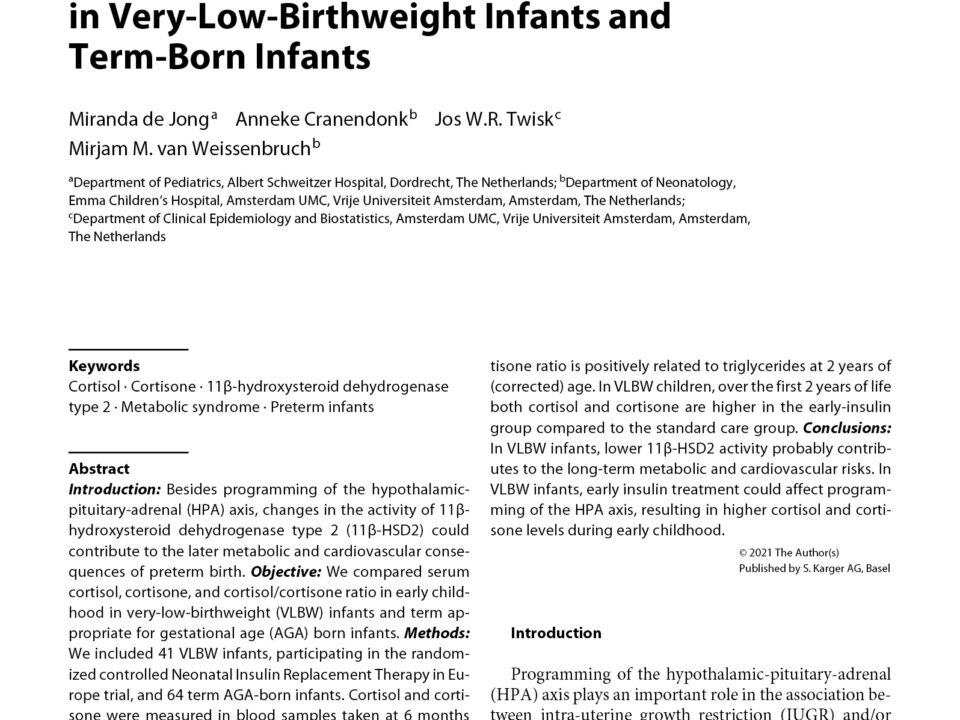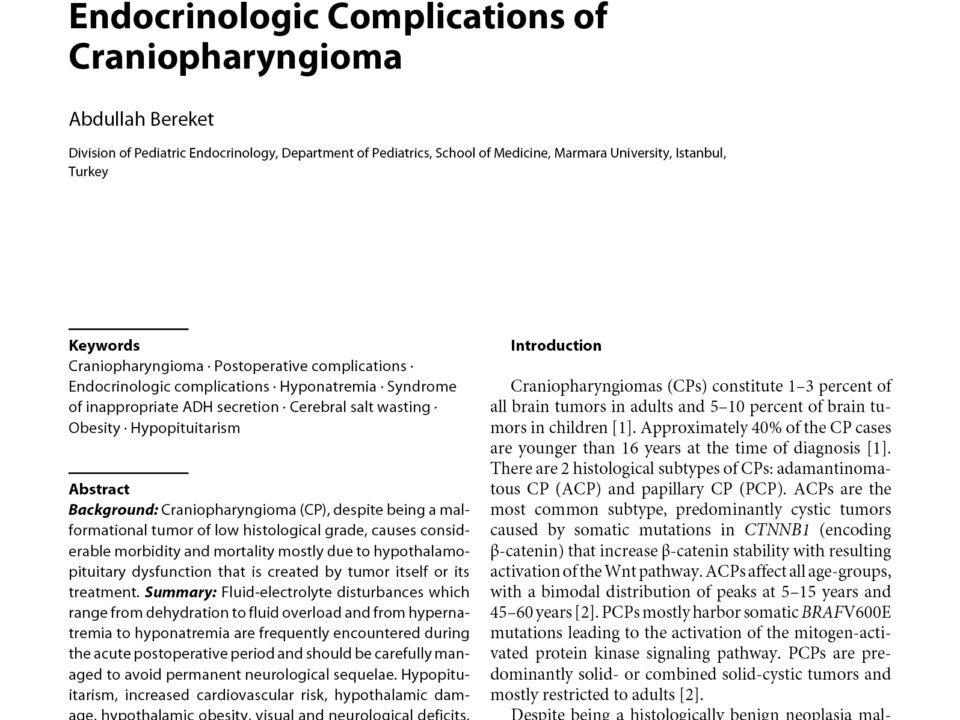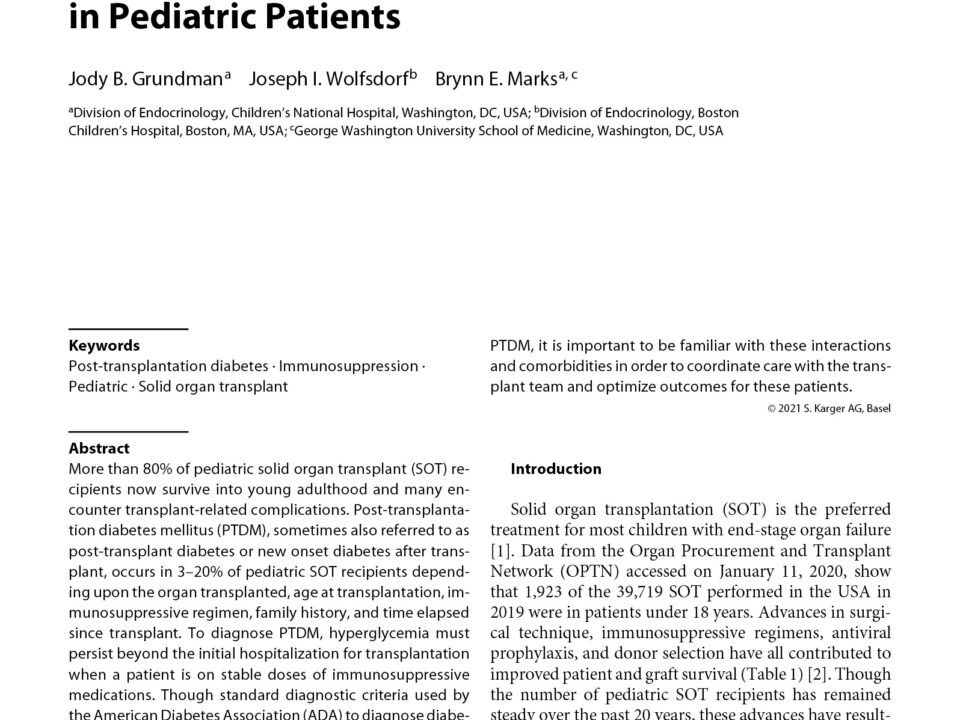December 13, 2022
Background: Mutations of the insulin receptor (INSR) gene lead to a wide spectrum of inherited insulin resistance (IR) syndromes. Among these, type A-IR, usually caused by dominant negative INSR mutations, generally presents peri-pubertally in girls. Case: A 2.8-year-old girl was referred due to recurrent postprandial and fasting hypoglycemia. She had been born at full-term with birth weight 1.89 kg, and had developed transient neonatal diabetes. Examination showed satisfactory growth, reduced adipose tissue, acanthosis nigricans, and isolated thelarche. After 12 h of fasting, she developed hypoglycemia (glucose 2.8 mmol/L), with inappropriately raised plasma insulin concentration of 5.4 mU/L and suppressed fatty acids and ketone bodies. Oral glucose tolerance testing showed severely increased plasma insulin concentration (>300 mU/L) with hypoglycemia (glucose 1.6 mmol/L) at 2.5 h. She was initially managed on dietary modifications, cornstarch, and then trialed on acarbose for postprandial hyperinsulinemic hypoglycemia (PPHH) with some response. However, she was noted to have increased frequency of hyperglycemia after a couple of years of treatment. She was then switched to metformin and continued to have dietary carbohydrate modification including cornstarch that improved fasting tolerance, hyperglycemia, and postprandial hypoglycemia. Genetic testing identified heterozygous deletion of the last exon of the INSR gene, exon 22. Conclusion: We present a case of type A-IR, caused by a novel INSR deletion, presenting unusually early with transient neonatal diabetes, followed by episodes of hypoglycemia and hyperglycemia during later childhood. Early life presentations, including neonatal diabetes and PPHH, should lead to consideration of type A-IR.
December 13, 2022
Introduction: The thyroid parafollicular hormone calcitonin (CT) shows particularly high blood levels in early childhood, a period of high bone turnover, which decrease with increasing age. Data about the physiological role of CT during infancy, childhood, and adolescence are contradictory or lacking. Objective: We hypothesize that CT demonstrates age-related correlations with parameters of bone growth and turnover as well as with parameters of calcium homeostasis. Methods: 5,410 measurements of anthropometric data and venous blood samples were collected from 2,636 participants of the LIFE Child study, aged 2 months–18 years. Univariate correlations and multiple regression analysis were performed between serum CT and anthropometric indicators (height standard deviation scores [SDS] and BMI-SDS), markers of calcium (Ca) homeostasis (Ca, parathyroid hormone, 25-OH vitamin D, and phosphate [P]), bone formation (procollagen type 1 N-terminal propeptide [P1NP], osteocalcin), and bone resorption (β-CrossLaps). Results: CT was significantly associated with Ca (β = 0.26, p < 0.05) and P1NP/100 (β = 0.005, p < 0.05) in children aged 2 months–1.1 years. These relations were independent of age and sex and could not be confirmed in children aged 1.1–8 years. Independent of age, sex, puberty, P, and height SDS CT showed a significant positive relation to Ca (β = 0.26; p < 0.001) in children aged 8–18 years. Conclusions: Our findings suggest a unique association between CT and Ca in periods of rapid bone growth and point to a possible involvement of CT in promoting bone formation during the first year of life.
December 13, 2022
Introduction: Few data exist on long-term growth hormone (GH) treatment in patients with Noonan syndrome (NS). Objective: To evaluate the effectiveness and safety of GH treatment in NS in clinical practice. Methods: Height gain, near-adult height (NAH), and safety were assessed in 2 complementary non-interventional studies: NordiNet® IOS and ANSWER. The safety analysis included 412 patients, and the effectiveness analysis included 84 GH-treated patients (male, n = 67) with ≥4 years’ height standard deviation score (HSDS) data. HSDS was determined using national reference (NR) and NS-specific (NSS) data. Results: The mean (SD) baseline age was 8.38 (3.57) years; HSDS, −2.76 (1.03); GH dose, 41.6 (11.1) µg/kg/day. The mean (SD) HSDS increase from baseline (ΔHSDS) was 0.49 (0.37) (first year), 0.79 (0.58) (second year), and 1.01 (0.60) (third year) (NR). The mean (SD) HSDS at year 3 was −1.66 (1.00) (NR; 1.06 [1.12] [NSS]). Twenty-four patients achieved NAH. The mean (SD) NAH SDS (NR) was −1.51 (0.60) (154.90 [3.21] cm) in females and −1.79 (1.09) (165.61 [7.19] cm) in males; 70.8% (17/24) had NAH SDS ≥ −2. Adverse drug reactions and GH-unrelated serious adverse events (n = 34) were reported in 22/412 (5.3%) patients. Four neoplasms and 3 cases of scoliosis were reported; no cardiovascular adverse events occurred. Conclusions: GH-treated children with NS achieved substantial height gain during the first 3 years of follow-up. Overall, 24 patients achieved NAH, with 70.8% having NAH SDS ≥ –2. There was no evidence to support a higher prevalence of neoplasm, or cardiac or other comorbidities.
December 13, 2022
Turner syndrome (TS), characterized by the partial or complete absence of an X-chromosome, provides a unique insight into the role of the X-chromosome and the immune system. While women have a 10-fold higher incidence of autoimmune disease (AD) compared with men, the risk in women with TS is thought to be further doubled. TS is associated with a propensity for a wide variety of ADs that increase in incidence across the life span. Isochromosome Xq as well as isolated Xp deletion karyotypes may predispose to higher rates of AD in TS suggesting the impact of X-chromosome gene dosage. It is likely, however, that epigenetic changes across the genome and the hormonal milieu may also have a profound impact on the immune profile in TS. This review explores the immune phenotype and the spectrum of ADs in TS. Genotype-phenotype correlations are presented with a brief overview of the genetic and hormonal underpinnings.
December 13, 2022
Background: Diabetes diagnosed within the first 6 months of life is defined as neonatal diabetes mellitus (NDM). Mutations in the KCNJ11, ABCC8, and INS genes are the most common cause of permanent NDM. In populations with a high rate of consanguinity, Wolcott-Rallison syndrome caused by biallelic EIF2AK3 mutations is common. Methods: We studied the clinical characteristics and underlying genetic cause of disease in 15 individuals with diabetes onset before 6 months of age as defined by sustained hyperglycaemia requiring insulin treatment. Patients who had a remission of the diabetes, defined by a normal blood glucose and HbA1c value without insulin or sulphonylurea (SU) treatment, within the first 18 months of life were classified as having transient NDM (TNDM). Results: We report 15 patients with NDM from 14 unrelated families, including 10 with reported parental consanguinity. 1/15 patients had a remission of diabetes, leading to a diagnosis of TNDM. Mutations were detected in 80% (n = 12/15) of the cohort (ABCC8 [n = 4], PTF1A-distal enhancer [n = 3], KCNJ11 [n = 2], EIF2AK3 [n = 1], INS [n = 1], and SLC19A2 [n = 1]). All cases were initially treated with multiple dose insulin injections. One patient with an ABCC8 mutation transitioned from insulin to SU resulting in improved metabolic control at the age of 20 years. Conclusion: Although the number of individuals born to consanguineous parents was considerably high in this cohort, KATP channel mutations (ABCC8/KCNJ11) were more common than EIF2AK3 mutations (n = 6 vs. n = 1). Genetic analyses should be performed in all NDM cases due to the potential impact on treatment and prognosis.
December 13, 2022
Introduction: Besides programming of the hypothalamic-pituitary-adrenal (HPA) axis, changes in the activity of 11β-hydroxysteroid dehydrogenase type 2 (11β-HSD2) could contribute to the later metabolic and cardiovascular consequences of preterm birth. Objective: We compared serum cortisol, cortisone, and cortisol/cortisone ratio in early childhood in very-low-birthweight (VLBW) infants and term appropriate for gestational age (AGA) born infants. Methods: We included 41 VLBW infants, participating in the randomized controlled Neonatal Insulin Replacement Therapy in Europe trial, and 64 term AGA-born infants. Cortisol and cortisone were measured in blood samples taken at 6 months and 2 years corrected age (VLBW children) and at 3 months and 1 and 2 years (term children). At 2 years of (corrected) age (HDL) cholesterol, triglycerides, glucose, and insulin were also measured. Results: During the first 2 years of life, cortisol/cortisone ratio is higher in VLBW children compared to term children. In the total group of children, cortisol/cortisone ratio is positively related to triglycerides at 2 years of (corrected) age. In VLBW children, over the first 2 years of life both cortisol and cortisone are higher in the early-insulin group compared to the standard care group. Conclusions: In VLBW infants, lower 11β-HSD2 activity probably contributes to the long-term metabolic and cardiovascular risks. In VLBW infants, early insulin treatment could affect programming of the HPA axis, resulting in higher cortisol and cortisone levels during early childhood.
December 13, 2022
Background: Craniopharyngioma (CP), despite being a malformational tumor of low histological grade, causes considerable morbidity and mortality mostly due to hypothalamo-pituitary dysfunction that is created by tumor itself or its treatment. Summary: Fluid-electrolyte disturbances which range from dehydration to fluid overload and from hypernatremia to hyponatremia are frequently encountered during the acute postoperative period and should be carefully managed to avoid permanent neurological sequelae. Hypopituitarism, increased cardiovascular risk, hypothalamic damage, hypothalamic obesity, visual and neurological deficits, and impaired bone health and cognitive function are the morbidities affecting the well-being of these patients in the long term. Key Messages: Timely and optimal treatment of early postoperative and long-term complications of CP is crucial for preserving quality of life of these patients.
December 13, 2022
More than 80% of pediatric solid organ transplant (SOT) recipients now survive into young adulthood and many encounter transplant-related complications. Post-transplantation diabetes mellitus (PTDM), sometimes also referred to as post-transplant diabetes or new onset diabetes after transplant, occurs in 3–20% of pediatric SOT recipients depending upon the organ transplanted, age at transplantation, immunosuppressive regimen, family history, and time elapsed since transplant. To diagnose PTDM, hyperglycemia must persist beyond the initial hospitalization for transplantation when a patient is on stable doses of immunosuppressive medications. Though standard diagnostic criteria used by the American Diabetes Association (ADA) to diagnose diabetes are employed, clinicians need to be aware of the limitations of using these criteria in this unique patient population. Management of PTDM parallels strategies used for type 2 diabetes (T2D), while also carefully considering comorbidities and potential interactions with immunosuppressive medications in these patients. In caring for patients with PTDM, it is important to be familiar with these interactions and comorbidities in order to coordinate care with the transplant team and optimize outcomes for these patients.
December 13, 2022
Background: Gonadotropin-releasing hormone analogues (GnRHa) administered as depot formulations are the standard of care for children with central precocious puberty (CPP). Puberty resumes after treatment discontinuation, but little is known concerning fertility in women who have been treated with GnRHa for CPP during childhood. Methods: The PREFER (PREcocious puberty, FERtility) study prospectively analysed fertility, via a series of questionnaires, in women treated during childhood with triptorelin (depot formulation) for CPP. Co-primary endpoints were the proportion of women wanting a pregnancy any time before study inclusion and during the follow-up period but not pregnant 6 and 12 months after stopping contraception and the waiting time to pregnancy (WTP). Results: A total of 574 women were identified, and 194 women were included in the analysis. Although there were not enough data for primary endpoint assessment, few women (1.7%) reported issues with fertility or were unable to become pregnant despite trying to conceive. Most pregnancies (84.4%, 95% CI [67.2–94.7%]) occurred within 1 year of trying to conceive, in line with the WTP for women without previous CPP. Conclusion: The results, based on a limited sample of patients, suggest that CPP treated with triptorelin does not negatively impact women’s fertility in adulthood. These results need to be consolidated with a subsequent study performed when these women will have reached their mid-thirties.
